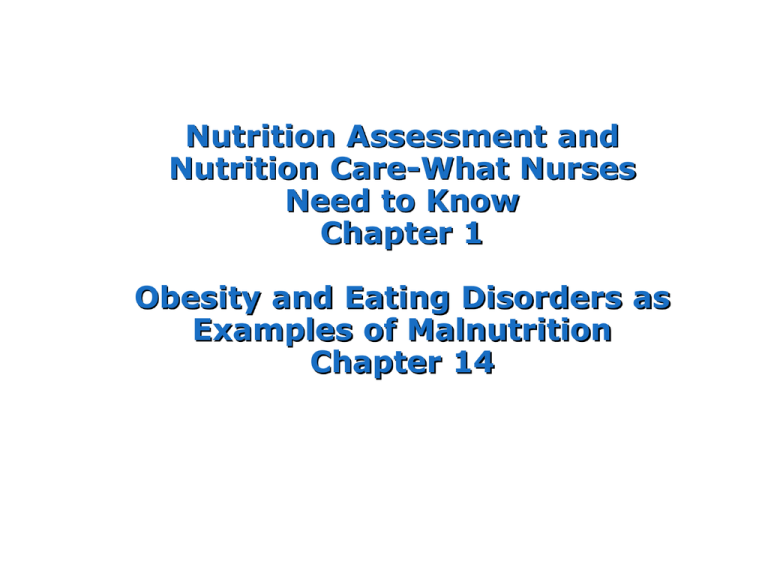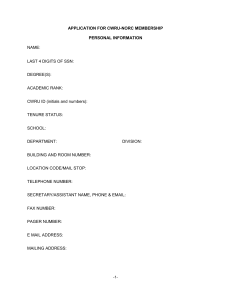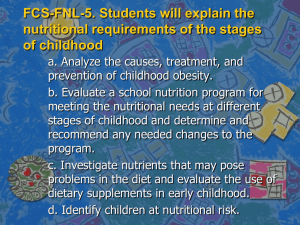Lecture 4b powerpoint
advertisement

Nutrition Assessment and Nutrition Care-What Nurses Need to Know Chapter 1 Obesity and Eating Disorders as Examples of Malnutrition Chapter 14 Nutritional Screening • Nutritional screen – Quick look at a few variables to judge a client’s relative risk for nutritional problems – No accepted universal tool – Screen must be done within 24 hours of admission to the hospital. Nutritional Screening—(cont.) • Comprehensive nutritional assessment – Moderate to high risk at screening referred to dietitian for assessment-dietitian may not always be available so nurses/physicians may very well have to do all four steps below – Nutritional care process: four steps o Assessment o Nutritional diagnosis o Implementation o Monitoring and evaluation Nutritional Screening—(cont.) • Comprehensive nutritional assessment—(cont.) – Different from nursing care plan o Dietitians (if available) or otherwise nurses/physicians can get most of information from nursing admission assessment. o Dietitians (if available) or otherwise nurses/physicians interview patients and/or families to obtain a nutrition history. – Helps to differentiate o Nutrition problems caused by inadequate intake from those caused by disease Nutritional Screening—(cont.) • Comprehensive nutritional assessment—(cont.) – Dietitians (if available) or otherwise nurses/physicians o Calculate estimated calorie and protein requirements based on the assessment data o Determine nutrition diagnoses that define the nutritional problem, etiology, and signs and symptoms o May also determine the appropriate malnutrition diagnosis o Formulate nutrition interventions Integrating Nutrition • Assessment – Data classified as ABCD o Anthropometric o Biochemical o Clinical o Dietary data – Client’s medical–psychosocial history is also evaluated for its impact on nutritional status. Integrating Nutrition—(cont.) • Anthropometric data – Physical measurements of the body – Body mass index o “Healthy” or “normal” BMI is defined as 18.5 to 24.9. o Above or below related to health risks – Edema or dehydration skews accurate weight measurements. – Recent weight change Integrating Nutrition—(cont.) • Biochemical data – No single test is both sensitive and specific for protein–calorie malnutrition. – Biochemical data may help support the diagnosis of a nutritional problem. Integrating Nutrition—(cont.) • Albumin – Often used to assess protein status – Serum levels may be maintained until malnutrition is in a chronic stage. – Low albumin may indirectly identify patients who may benefit from nutrition assessment and intervention. • Prealbumin – Thyroxin-binding protein – More sensitive indicator of protein status – More expensive to measure Integrating Nutrition—(cont.) • Clinical data – Physical signs and symptoms of malnutrition observed in the client – Most signs cannot be considered diagnostic. – Physical signs and symptoms of malnutrition can vary in intensity among population groups because of genetic and environmental differences. – Physical findings occur only with overt malnutrition. Integrating Nutrition—(cont.) • Dietary data – Nurse should ask, “Do you avoid any particular foods?” – Nurse should not ask, “Are you on a diet?” • Medical–psychosocial history – May shed light on factors that influence intake, nutritional requirements, or nutrition counseling Integrating Nutrition—(cont.) • Medication – Both prescription and over-the-counter drugs have the potential to affect and be affected by nutritional status. – At greatest risk for development of drug-induced nutrient deficiencies include those who: o Habitually consume fewer calories and nutrients than they need o Have increased nutrient requirements including infants, adolescents, and pregnant and lactating women o Are elderly o Have chronic illnesses Integrating Nutrition—(cont.) • Medication—(cont.) – At greatest risk for development of drug-induced nutrient deficiencies include those who—(cont.) o Take large numbers of drugs (five or more), whether prescription drugs, over-the-counter medications, or dietary supplements o Are receiving long-term drug therapy o Self-medicate o Are substance abusers Integrating Nutrition—(cont.) • Nursing diagnosis – Provide written documentation of the client’s status – Serve as a framework for the plan of care that follows • Planning: client outcomes – Outcomes, or goals, should be measurable, attainable, specific, and client centered. – Focus on the client, not the health-care provider. – Keep in mind that the goal for all clients is to consume adequate calories, protein, and nutrients using foods they like and tolerate as appropriate. Integrating Nutrition—(cont.) • Nursing interventions – Nutrition therapy o Diet is a four-letter word with negative connotations. o Usually general suggestions to increase/ decrease, limit/avoid, reduce/encourage, or modify/maintain aspects of the diet because exact nutrient requirements are determined on an individual basis. o Nutrition theory does not always apply to practice. Integrating Nutrition—(cont.) • Nursing interventions—(cont.) – Client teaching o Clients in clinical settings may be more receptive to nutritional advice. o Hospitalized patients are also prone to confusion about nutrition messages. • Monitoring and evaluation – Monitoring precedes evaluation. – Evaluation assesses whether client outcomes were achieved. Physical Signs and Symptoms of Malnutrition • Hair is dull, brittle, dry, or falls out easily • Swollen glands of neck and cheeks • Dry, rough, or spotty skin • Poor or delayed wound healing or sores • Thin appearance with lack of subcutaneous fat • Muscle wasting • Edema of lower extremities • Weakened hand grasp • Depressed mood • Abnormal heart rate/rhythm and BP • Enlarged liver or spleen • Loss of balance and coordination Nursing Diagnoses with Nutritional Significance • Altered nutrition: more than body requirements • Altered nutrition: less than body requirements • Altered nutrition: risk for more than body requirements • Constipation • Diarrhea • Fluid volume excess • Fluid volume deficit Nursing Diagnoses with Nutritional Significance—(cont.) • • • • • • • • • Risk for aspiration Altered oral mucous membrane Altered dentition Impaired skin integrity Noncompliance Impaired swallowing Knowledge deficit Pain Nausea Obesity and Eating Disorders as Examples of Malnutrition Malnutrition Chapter 14 Obesity and Eating Disorders • Prevalence of obesity (BMI ≥30) increasing • One of the most common causes of preventable death • A far less common weight issue is disordered eating manifested as anorexia nervosa or bulimia. • Historically, the study of obesity and eating disorders has been separate. • Commonalities between them Obesity • Overweight is defined as having a BMI ≥25. • Obesity is defined as having a BMI ≥30. • Waist circumference is a better measure than BMI Obesity—(cont.) • Causes of obesity – Occurs when people eat more calories than they expend over time – Why it occurs is not fully understood. – Some people are able to burn hundreds of extra calories in the activities of daily living to help control weight. – Likely that a combination of genetic and environmental factors is involved. Obesity—(cont.) • Genetics – Estimates on the heritability of body mass index range from 40% to 70% (Herrera and Lindgren, 2010). – Genetics are involved in: o How likely a person is to gain or lose weight o Where body fat is distributed o Response to overeating Obesity—(cont.) • Environment – Rise in obesity without change in gene poolepigenetics can play a role – Root cause in most cases is lifestyle and environment, not biology. – Environmental influences include o Abundance of palatable, low-cost, high–calorie density foods that are readily available in prepackaged forms and in fast-food restaurants o Increasing consumption of soft drinks and snacks o Great proportion of food expenditures spent on food away from home Obesity—(cont.) • Environment—(cont.) – Environmental influences include—(cont.) o Growing portion size of restaurant meals o Low levels of physical activity o Increases in television watching o Widespread use of electronic devices in the home, such as computers and video games – All lead to sedentary lifestyle. Obesity—(cont.) • Environment—(cont.) – Gene–environment interaction o In people with a genetic predisposition to obesity, the severity of the disease is largely determined by lifestyle and environmental conditions. • Complications of obesity – Most common complications of obesity include o Insulin resistance, type 2 diabetes, hypertension, dyslipidemia, cardiovascular disease, stroke, gallstones and cholecystitis, sleep apnea, respiratory dysfunction, and increased incidence of certain cancers (e.g. colon, breast, prostate,endometrial) Obesity—(cont.) • Complications of obesity—(cont.) – Increases the risk of complications during and after surgery – Obesity is considered to be a major contributor to preventable deaths in Canada. – Obesity presents psychological and social disadvantages. – Negative social consequences Obesity—(cont.) • Goals of treatment – Ideally, treatment would “cure” overweight and obesity. – In reality, this ideal is seldom achieved. – A modest weight loss of 5% to 10% of initial body weight is associated with significant improvements in blood pressure, cholesterol and plasma lipid levels, and blood glucose levels. Obesity—(cont.) • Goals of treatment—(cont.) – Modest weight loss 1. Is more attainable 2. Is easier to maintain over the long term 3. Sets the stage for subsequent weight loss Obesity—(cont.) • Evaluating motivation to lose weight – Objectively identifying who may benefit from weight loss – Assessing the client’s level of motivation is crucial. – Imposing treatment on an unmotivated or unwilling client may preclude subsequent attempts at weight loss. Obesity—(cont.) • Evaluating motivation to lose weight—(cont.) – Treatment approaches o A lifestyle approach is the basis of treatment for all people whose BMI is ≥30. Includes diet modification Exercise Behavior modification o Pharmacotherapy and surgery may be used in conjunction with lifestyle interventions, based on the individual’s BMI and the presence of comorbidities. Obesity—(cont.) • Treatment approaches—(cont.) – Diet modification o Cornerstone of most weight loss programs o Fewer calories o Macronutrient composition o Micronutrient composition o Nutrition education o Promoting dietary adherence Obesity—(cont.) • Treatment approaches—(cont.) – Physical activity o Benefits of exercise are numerous. o Favorably impacts metabolic rate Obesity—(cont.) • Physical activity—(cont.) – Sixty to 90 minutes of daily moderate-intensity physical activity are recommended to sustain weight loss. – Promoting exercise adherence o Seems to increase with less structure o Strategies that may promote exercise adherence Exercise at home Exercise in multiple short bouts (10 minutes each) Adopt a more active lifestyle Obesity—(cont.) • Behavior modification – Focuses on changing the client’s eating and exercise behaviors – Key behavior modification strategies o Self-monitoring o Goal setting o Stimulus control o Problem solving o Cognitive restructuring o Relapse prevention Obesity—(cont.) • Pharmacotherapy – Recommended for o People with a BMI ≥30 o People with a BMI ≥27 with comorbid conditions o People with waist circumferences at or above IDF cut offs are also candidates for pharmacotherapy if comorbidities are present. Obesity—(cont.) • Pharmacotherapy—(cont.) – Drugs are central nervous system stimulants. – Tolerance may develop after only a few weeks. – Risk of abuse – Common side effects o Increased heart rate and blood pressure, dry mouth, agitation, insomnia, nausea, diarrhea, and constipation Obesity—(cont.) • Surgery – Most effective treatment for severe obesity – Appropriate for clients whose BMI is 35 to 39.9 who have major comorbidities – Works by 1. Restricting the stomach’s capacity 2. Creating malabsorption of nutrients and calories 3. A combination of both Obesity—(cont.) • Surgery—(cont.) – Laparoscopic adjustable gastric banding (LAGB) o An inflatable band encircles the uppermost stomach and is buckled. o Small pouch of approximately 15- to 30-mL capacity is created with a limited outlet between the pouch and the main section of the stomach. o Outlet diameter can be adjusted by inflating or deflating a small bladder inside the “belt” through a small subcutaneous reservoir. Obesity—(cont.) • Surgery—(cont.) – Laparoscopic adjustable gastric banding (LAGB)—(cont.) o Size of the outlet can be repeatedly changed as needed. o Mortality rate for gastric banding is the lowest of all bariatric procedures. o Successful weight loss after LAGB requires frequent follow-up and band adjustments. Obesity—(cont.) • Surgery—(cont.) – Roux-en-Y gastric bypass (RYGB) o Combines gastric restriction to limit food intake with the construction of bypasses of the duodenum and the first portion of the jejunum o Creates malabsorption of nutrients o “Dumping syndrome” o Superior to gastric resection in both promoting and maintaining significant weight loss o Major complication with RYGB is anastomotic leak. Obesity—(cont.) • Postsurgical diet – Progression begins with small quantities of sugar-free clear liquids. – Advances as tolerated to full liquids, followed by pureed foods, and then a regular diet within 5 to 6 weeks after surgery – Nutrition therapy guidelines Obesity—(cont.) • Weight maintenance after loss – Keeping weight off is even harder than losing it. – Diets that lead to weight loss are not necessarily effective for maintaining weight loss. – Single best predictor of who will be successful at maintaining weight loss is how long someone has kept his or her weight off. Obesity—(cont.) • Obesity prevention – Small changes in diet and exercise that total a mere 100 cal/day may be enough to prevent obesity in most of the population. – One ounce of cheddar cheese a day for 1 year = 10-pound weight gain Eating Disorders: Anorexia Nervosa (AN), Bulimia Nervosa (BN), and Eating Disorders Not Otherwise Specified (EDNOS) • Defined psychiatric illnesses that can have a profound impact on nutritional status and health • Generally characterized by abnormal eating patterns and distorted perceptions of food and body weight • Continuum of disordered eating Eating Disorders: Anorexia Nervosa (AN), Bulimia Nervosa (BN), and Eating Disorders Not Otherwise Specified (EDNOS)—(cont’d) • Etiology – Considered to be multifactorial in origin – Risk factors o Dieting, early childhood eating and GI problems, increased concern about weight and size, negative self-evaluation, sexual abuse, and other traumas Eating Disorders: Anorexia Nervosa (AN), Bulimia Nervosa (BN), and Eating Disorders Not Otherwise Specified (EDNOS)—(cont.) • Etiology—(cont.) – Precipitating factors o Onset of puberty, parents’ divorce, death of a family member, and ridicule of being or becoming fat – People with eating disorders often suffer from o Depression, anxiety, substance abuse, or body dysmorphic disorder Eating Disorders: Anorexia Nervosa (AN), Bulimia Nervosa (BN), and Eating Disorders Not Otherwise Specified (EDNOS)—(cont.) • Etiology—(cont.) – Treatment plans are highly individualized. – Antidepressant drugs effectively reduce the frequency of problematic eating behaviors. – Most eating disorders are treated on an outpatient basis. – Nutritional intervention seeks to reestablish and maintain normal eating behaviors. Nutrition Therapy for Anorexia • Step-by-step goals of nutrition therapy 1. To prevent further weight loss 2. To gradually reestablish normal eating behaviors 3. To gradually increase weight 4. To maintain agreed-on weight goal • Half of those who receive care are expected to recover. • Overall mortality rate is 5% to 16%. Nutrition Therapy for Anorexia—(cont.) • Involving the client in formulating individualized goals and plans promotes compliance. • Large amounts of food may not be well tolerated. Nutrition Therapy for Bulimia Nervosa • People with BN tend to have fewer serious medical complications than people with AN because their undernutrition is less severe. • Nutritional counseling focuses on identifying and correcting food misinformation and fears. • Structured and relatively inflexible to promote the client’s sense of control • Initial meal plan provides adequate calories for weight maintenance. Nutrition Therapy for Bulimia Nervosa— (cont.) • Adequate fat is provided to help delay gastric emptying and contribute to satiety. • Calories are gradually increased as needed. Eating Disorders Not Otherwise Specified • At least as common as AN and BN • This group represents – Subacute cases of AN or BN – Binge eating disorder






